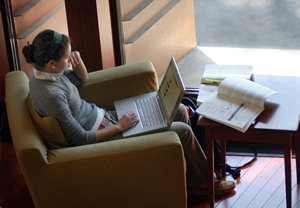 With the school year at a close, university administrators have a new class of arrivals to look forward to in the fall, and with that a new set of technology dilemmas for campus IT staff. That was the problem I faced as director of network services at Salve Regina University until we introduced a student laptop program to provide standardized technology for our faculty and students.
With the school year at a close, university administrators have a new class of arrivals to look forward to in the fall, and with that a new set of technology dilemmas for campus IT staff. That was the problem I faced as director of network services at Salve Regina University until we introduced a student laptop program to provide standardized technology for our faculty and students.
Salve Regina was chartered by the State of Rhode Island in 1934, founded under the sponsorship of the Sisters of Mercy as an independent institution built on Catholic educational traditions. The school has grown over the years and now enrolls 2,600 students from 42 states and 17 nations.
The laptop program began as an option for students, but without ensuring all students have an equal technology experience, we lacked the ability to facilitate on-site support, provide a ubiquitous wireless network, and assure consistent student experience and capabilities. By outfitting our campus with standardized technology, including Hewlett-Packard notebooks, desktop PCs, printers, servers, and storage systems, we were able to infuse technology into the academic experience and grow the laptop program into a mandatory experience so all students could benefit.
What’s more, to support the program and offset the costs of the program, we developed a self-maintainer program which allowed university employees to become HP certified hardware technicians and provide on-site warranty service as a way to earn compensation for the school and avoid shipping costs to the manufacturer.
For students and faculty, the ability to collaborate anytime, anywhere and access a variety of educational resources meant a consistent user experience. The notebooks gave them the key to reach out to the world. And they communicate constantly, so they don’t have to wait for a particular classroom hour together.
With the Blackboard student learning management system, teachers could disseminate schedules, a class syllabus, assignments, and other learning resources, and then collect papers for grading and later, return them to students. For students, creating an ePortfolio as a way to record academic achievements and learning experiences meant they were developing the ability to use and adapt to technology–a skill they could take with them after college.
The laptop program not only put a notebook in front of every student and teacher but it also allowed educators to step away from the front of the classroom and use technology to create a more interactive environment. Integrating HP Tablet PCs in the curriculum enabled teachers to gather student feedback in real time, to foster collaboration in the classroom, make the most of each class hour, and promote effective studying and preparation.
I remember trying to manage a residential computing program on our own–it was a monster, but now in its fourth year, the student laptop program has become a success as we save money and continue to build a solid relationship with our IT suppliers.
Glenn Clark is the director of network services at Salve Regina University, Newport, R.I.
- Friday 5: College and career readiness - April 12, 2024
- Cybersecurity: eSN Innovation Roundtable - April 11, 2024
- School-home communication remains a challenge for many districts - April 10, 2024

